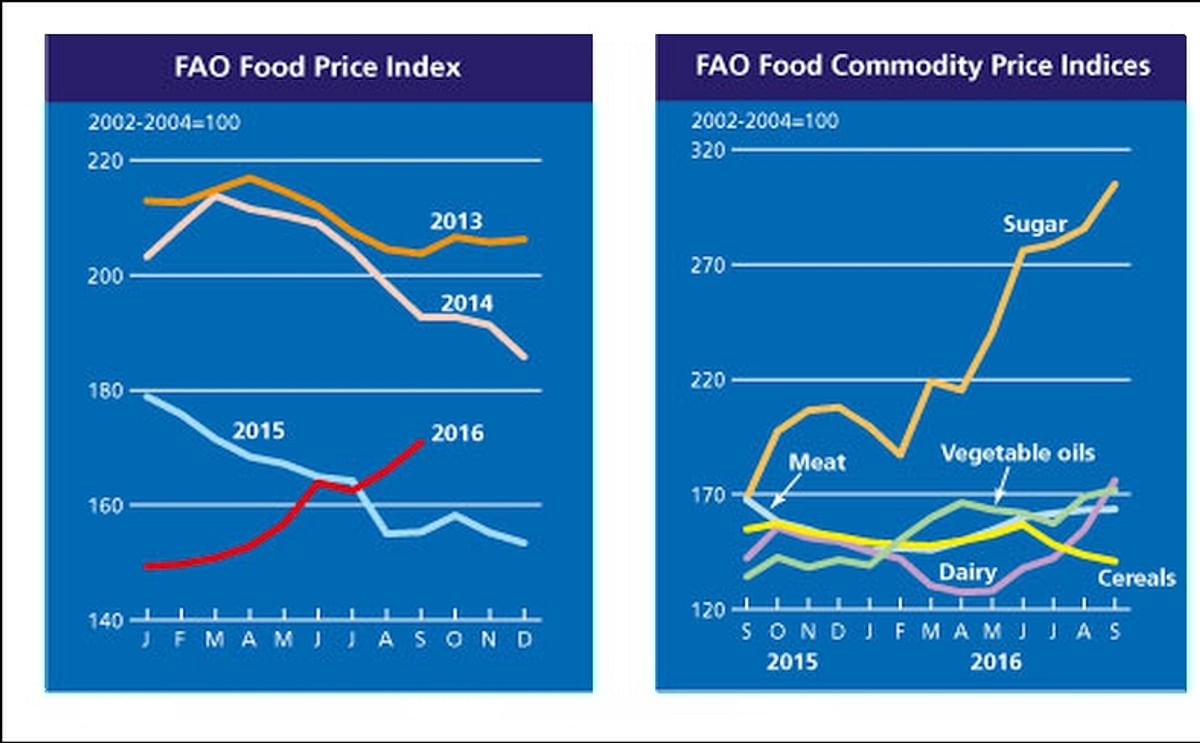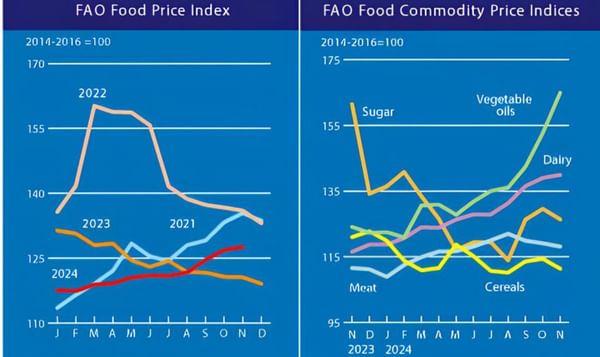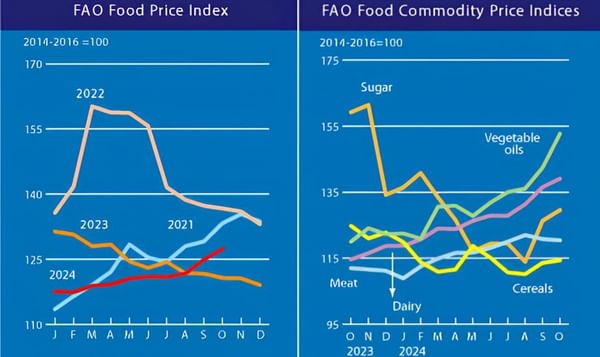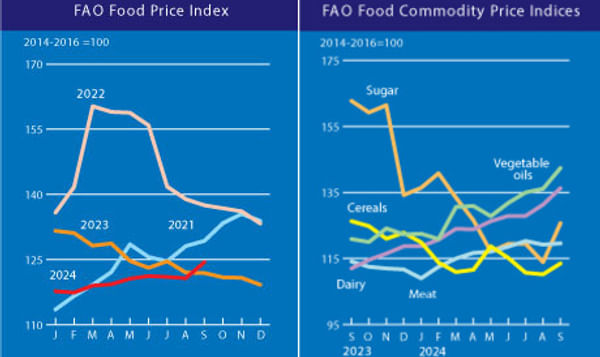In September 2016, the FAO Food Price Index (FFPI) averaged 170.9 points, up almost 5 points (2.9 percent) from August and 10 percent above the corresponding month last year.
The September value is the highest since March 2015.
Global Food Prices continue to go up in September

In September 2016, the FAO Food Price Index (FFPI) averaged 170.9 points, up almost 5 points (2.9 percent) from August and 10 percent above the corresponding month last year.
The September value is the highest since March 2015. Barring a small dip in July, the FFPI has been going up steadily since the start of the year, mainly supported by a surge in sugar prices and more moderate increases for dairy products, meat and oils. Last month’s rise in the FFPI was driven mostly by stronger dairy and sugar quotations.
The FAO Cereal Price Index averaged 140.9 points in September, down 2.7 points (1.9 percent) from August and 8.9 percent below its year-earlier level. The decline in September marked the third consecutive month of decreases, largely due to ample global supplies, especially export availabilities. This year’s record wheat production, coupled with an expected rebound in global rice production and above-average performance of coarse grains, maize in particular, have continued to weigh on cereal export quotations.
The FAO Vegetable Oil Price Index averaged almost 172 points in September, up 2.9 points (or 1.7 percent) from August, reflecting higher quotations of palm, soy and rapeseed oils. Palm oil values continued to strengthen, underpinned by weaker than anticipated output growth and low stock levels in both exporting and importing countries. International soyoil quotations appreciated on tight global export availabilities, while rapeseed oil prices firmed on concerns about global output falling for a third consecutive year in 2016/17.
The FAO Dairy Price Index averaged 176 points in September, up as much as 21 points (13.8 percent) from August. Quotations rose for all dairy products, in particular butter, which was bolstered by reduced stocks and strong internal demand in the EU. The Index has risen by 49 points, 38 percent, since April. The current price surge stems from expectations that falling milk production in the EU and a muted opening to the dairy year in Oceania would result in tighter availabilities for export, following excess supplies in the preceding two years.
The FAO Meat Price Index averaged 163.5 points in September, essentially unchanged from August. Since January, when it hit a five-year low, the Index has risen by 12.6 percent. The largest increase for the year so far has been recorded for pigmeat, followed by ovine and poultry meat, while bovine meat experienced only a limited rise. Firm international demand, in particular from Asia, underpinned pigmeat and poultry meat prices, while reduced international supplies reinforced those of ovine meat. Meanwhile, a recovery in bovine meat production in the United States has reduced the need for imports, contributing to a restrained international price rise for this commodity.
The FAO sugar price index averaged 304.8 points in September, up 19 points (6.7 percent) from August, the fifth consecutive monthly increase. The latest surge in international sugar prices was largely on the back of unfavourable weather conditions in the Centre South main producing region in Brazil, the world’s largest sugar producer and exporter. Reports of lower production in India, the world’s second largest sugar producer, and tight supplies in Thailand and China, also added to the upward pressure on prices.
The September value is the highest since March 2015. Barring a small dip in July, the FFPI has been going up steadily since the start of the year, mainly supported by a surge in sugar prices and more moderate increases for dairy products, meat and oils. Last month’s rise in the FFPI was driven mostly by stronger dairy and sugar quotations.
The FAO Cereal Price Index averaged 140.9 points in September, down 2.7 points (1.9 percent) from August and 8.9 percent below its year-earlier level. The decline in September marked the third consecutive month of decreases, largely due to ample global supplies, especially export availabilities. This year’s record wheat production, coupled with an expected rebound in global rice production and above-average performance of coarse grains, maize in particular, have continued to weigh on cereal export quotations.
The FAO Vegetable Oil Price Index averaged almost 172 points in September, up 2.9 points (or 1.7 percent) from August, reflecting higher quotations of palm, soy and rapeseed oils. Palm oil values continued to strengthen, underpinned by weaker than anticipated output growth and low stock levels in both exporting and importing countries. International soyoil quotations appreciated on tight global export availabilities, while rapeseed oil prices firmed on concerns about global output falling for a third consecutive year in 2016/17.
The FAO Dairy Price Index averaged 176 points in September, up as much as 21 points (13.8 percent) from August. Quotations rose for all dairy products, in particular butter, which was bolstered by reduced stocks and strong internal demand in the EU. The Index has risen by 49 points, 38 percent, since April. The current price surge stems from expectations that falling milk production in the EU and a muted opening to the dairy year in Oceania would result in tighter availabilities for export, following excess supplies in the preceding two years.
The FAO Meat Price Index averaged 163.5 points in September, essentially unchanged from August. Since January, when it hit a five-year low, the Index has risen by 12.6 percent. The largest increase for the year so far has been recorded for pigmeat, followed by ovine and poultry meat, while bovine meat experienced only a limited rise. Firm international demand, in particular from Asia, underpinned pigmeat and poultry meat prices, while reduced international supplies reinforced those of ovine meat. Meanwhile, a recovery in bovine meat production in the United States has reduced the need for imports, contributing to a restrained international price rise for this commodity.
The FAO sugar price index averaged 304.8 points in September, up 19 points (6.7 percent) from August, the fifth consecutive monthly increase. The latest surge in international sugar prices was largely on the back of unfavourable weather conditions in the Centre South main producing region in Brazil, the world’s largest sugar producer and exporter. Reports of lower production in India, the world’s second largest sugar producer, and tight supplies in Thailand and China, also added to the upward pressure on prices.
Like to receive news like this by email? Join and Subscribe!
Join Our Telegram Channel for regular updates!
Highlighted Company
Sponsored Content
Sponsored Content
Sponsored Content
Sponsored Content
Sponsored Content











